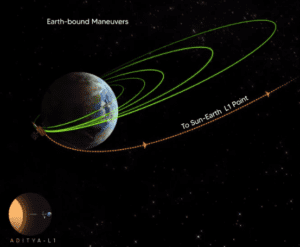In a remarkable milestone for India’s space endeavors, the Aditya-L1 Mission has taken a significant step forward on its journey towards the Sun-Earth L1 point. The successful execution of the Trans-Lagrangean Point 1 Insertion (TL1I) maneuver marks a pivotal moment in this mission. In this article, we explore the latest developments as Aditya-L1 embarks on its mission to study our Sun from this unique vantage point.

The Aditya-L1 spacecraft, India’s first dedicated solar mission, has successfully performed the Trans-Lagrangean Point 1 Insertion (TL1I) maneuver. This means that the spacecraft is now on a trajectory that will take it to the Sun-Earth L1 point.

- A Precision Maneuver
The TL1I maneuver, a crucial operation, has been executed with precision and success. This maneuver has positioned the Aditya-L1 spacecraft on a trajectory that will ultimately lead it to the Sun-Earth L1 point—an ideal vantage point for studying the Sun’s behavior and solar phenomena.
- The Path to L1
Over the next 110 days, Aditya-L1 will journey through space, following the carefully calculated trajectory set by ISRO’s scientists and engineers. This trajectory will culminate in the spacecraft being precisely injected into orbit around the Sun-Earth L1 point.

- ISRO’s Success Streak
Notably, this marks the fifth consecutive successful mission by the Indian Space Research Organisation (ISRO) involving the precise transfer of an object to a destination in the vast expanse of space. ISRO’s consistent achievements underscore its dedication to advancing space exploration and scientific research.

The L1 point is a Lagrange point, which is a point in space where the gravitational forces of two celestial bodies (in this case, the Sun and Earth) balance out. This allows the spacecraft to maintain a relatively stable orbit without using much fuel.
The Aditya-L1 spacecraft is expected to reach the L1 point in about 110 days. Once there, it will be injected into an orbit around L1 and begin its mission to study the Sun.

- What is the Aditya-L1 Mission?
The Aditya-L1 mission is expected to provide new insights into the Sun’s behavior and its impact on Earth’s climate. The mission will also help to develop new technologies for space-based solar observation.

- Benefits of the Aditya-L1 Mission
The Aditya-L1 mission is expected to have a number of benefits, including:
- Improved understanding of the Sun’s behavior and its impact on Earth’s climate
- Development of new technologies for space-based solar observation
- Enhanced space weather prediction capabilities
- Increased awareness of the importance of solar science and research

As the Aditya-L1 Mission progresses towards the Sun-Earth L1 point, anticipation builds for the invaluable insights it will provide into our Sun’s intricate workings. ISRO’s continued success in space missions reinforces India’s position in the global space community and its commitment to expanding our understanding of the cosmos. Stay tuned for more updates on this remarkable journey of discovery!
